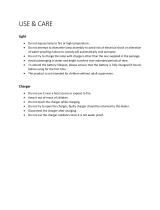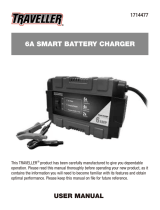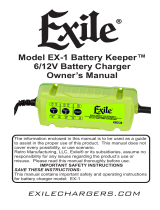CTEK CT5 Powersport Owner's manual
- Category
- Car battery chargers
- Type
- Owner's manual
CTEK CT5 Powersport is a fully automatic battery charger designed to extend the life of your 12V powersport batteries. It's suitable for all types of lead-acid batteries, including wet, EFB, MF, Ca/Ca, AGM, and GEL, and even the latest LiFePO4 batteries. The CT5 Powersport provides a maximum charging current of 2.3A and features a range of safety features to protect against overcharging, reverse polarity, and sparks.
CTEK CT5 Powersport is a fully automatic battery charger designed to extend the life of your 12V powersport batteries. It's suitable for all types of lead-acid batteries, including wet, EFB, MF, Ca/Ca, AGM, and GEL, and even the latest LiFePO4 batteries. The CT5 Powersport provides a maximum charging current of 2.3A and features a range of safety features to protect against overcharging, reverse polarity, and sparks.














-
 1
1
-
 2
2
-
 3
3
-
 4
4
-
 5
5
-
 6
6
-
 7
7
-
 8
8
-
 9
9
-
 10
10
-
 11
11
-
 12
12
-
 13
13
-
 14
14
CTEK CT5 Powersport Owner's manual
- Category
- Car battery chargers
- Type
- Owner's manual
CTEK CT5 Powersport is a fully automatic battery charger designed to extend the life of your 12V powersport batteries. It's suitable for all types of lead-acid batteries, including wet, EFB, MF, Ca/Ca, AGM, and GEL, and even the latest LiFePO4 batteries. The CT5 Powersport provides a maximum charging current of 2.3A and features a range of safety features to protect against overcharging, reverse polarity, and sparks.
Ask a question and I''ll find the answer in the document
Finding information in a document is now easier with AI
Related papers
-
CTEK CT5 POWERSPORT UK Owner's manual
-
CTEK NJORD® GO Owner's manual
-
CTEK NJORD GO User manual
-
CTEK CS FREE Owner's manual
-
CTEK PRO25S and PRO25SE Owner's manual
-
CTEK TIME TO GO Owner's manual
-
CTEK MXS 5.0 Owner's manual
-
CTEK PRO15S AU Owner's manual
-
CTEK PRO25S AU Owner's manual
-
CTEK MUS-4.3-TEST-and-CHARGE Owner's manual
Other documents
-
 Sunjoy 110203018 User guide
Sunjoy 110203018 User guide
-
Solar PL2545 Owner's manual
-
Solar PL2410 User manual
-
Schumacher Craftsman CMXCESM162 Automatic Battery Charger Craftsman CMXCESM258 Automatic Battery Charger Owner's manual
-
 Traveller 1714477 6A Smart Battery Charger User manual
Traveller 1714477 6A Smart Battery Charger User manual
-
Schumacher DSR5254 Automatic Battery Charging Station Owner's manual
-
RetroSound Exile EX-1 Battery Keeper Owner's manual
-
 Exile EX-1 Battery Keeper Owner's manual
Exile EX-1 Battery Keeper Owner's manual
-
Schumacher DSR125 Owner's manual
-
Schumacher DSR125 6V/12V 4-Bank Automatic Battery Charging Station Owner's manual
















